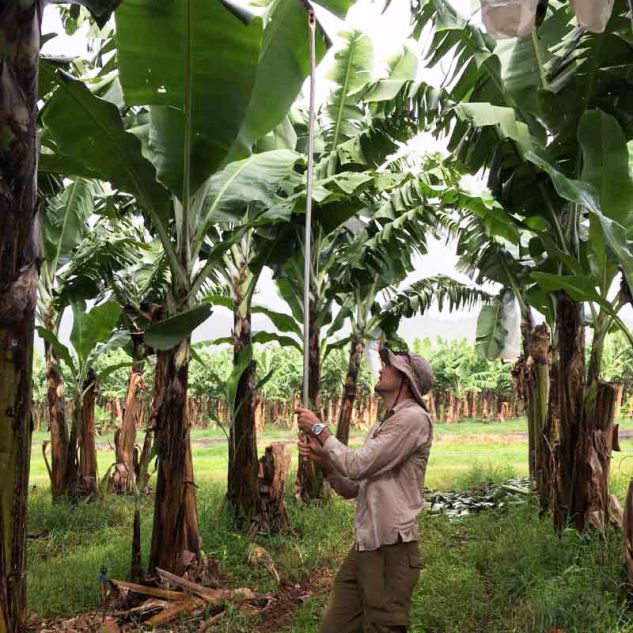College
College of Science and Engineering
Publish Date
22 May 2019
Related Study Areas
How our food sources depend on strong biodiversity
Biodiversity is often synonymous with the wild side of the animal kingdom: from the deadly to the colourful, the large to the small. But the more tame side of biodiversity, like sugar cane and cattle, plays an equally important role for life on earth, especially for humans.
JCU Associate Professor Paul Nelson is an agricultural and environmental scientist, making him an expert in the smallest members of the food chain: microorganisms.
“Most agriculture depends not just on plants and animal, but also on microorganisms,” Paul says.
“For example, most crop plants are not just plants; there’s a symbiotic relationship between plants and fungi that infect the roots and go out into the soil, called mycorrhizal fungi.
“That’s one example where there’s a direct effect on plant nutrition and water uptake, because the fungi actually help the plant. They cost the plant a bit too, because the fungi get their energy from the plant, but the plants directly depend on them.
“Agriculture is completely dependent on biodiversity. Agriculture is a natural system that we’ve modified and managed, but it involves many species that go into producing the product.”
The microscopic nature of these organisms means there are a lot of them, and the more you have, the better your plants will grow.
“Small animals like invertebrates, insects in particular, are much more numerous than plants and animals. And microorganisms are even more abundant and diverse than the invertebrates,” Paul says.
Managing ecosystems hands-on
Despite the astronomical numbers of these tiny, hardworking creatures, they still need to be protected. With the health of entire ecosystems dependent on them, sustainable agricultural practices are critical.
“Some people think about biodiversity being just in natural ecosystems that aren’t influenced too much by people, but there is a lot of biodiversity in managed systems as well, like agriculture,” Paul says.
According to Paul, when it comes to protecting the two kinds of biodiversity, the approach that needs to be taken swings from hands-off in the case of natural environments, to hands-on for the managed.
“If you’re conserving natural ecosystems, you need to conserve as much habitat as possible and minimise human pressure on those areas,” he says.
“In managed ecosystems you need to manage the system in a way that encourages maximum biodiversity.”
It’s worth taking good care of these managed systems for a few reasons, mostly because human beings need to eat and with poor biodiversity comes poor food security.
“If you’re conserving natural ecosystems, you need to conserve as much habitat as possible and minimise human pressure on those areas.”
JCU Associate Professor Paul Nelson


Protecting our ecosystems is no easy feat
“All organisms depend on resources, so if there are lots of resources for the organisms, then you’ll tend to get high biodiversity,” Paul says.
“Bees, for example, they require nectar; you need particular plants to provide that nectar.
“In the case of microorganisms and soil invertebrates, they depend on organic matter for food, so the more plant growth there is and the more that is returned to the soil, the more energy there will be for the organisms.”
It’s a cycle that can support itself without human intervention, but it's delicate and can deteriorate if you take out one of the key players.
Paul is a specialist in maintaining the quality of the soil habitat for plants and microorganisms, which helps maintain that aspect of the system.
Together with Ryan Orr, a PhD candidate, he’s part of a team fighting Panama disease of bananas in North Queensland, assessing how practical farm management techniques can be used to reduce the impact of the disease.
“The impact of Panama disease, which is caused by a soil fungus, is less severe when you have more diversity of microorganisms in the soil," Paul says.
“We’re looking at doing research to understand the habitat of the soil organisms, and manage the properties of the soil to give a good habitat for biodiversity.
“Soil organic matter, nutrients, pH, density are all things that farmers can manage and they all influence the microbiology of the soil.”

Featured researcher
Associate Professor Paul Nelson
Paul Nelson is an agricultural/environmental scientist with research, education and leadership experience in industry, government and university sectors. He does research and teaching in land and water science, and coordinates the Sustainable Tropical Agriculture Flagship of JCU’s Centre for Tropical Environmental and Sustainability Science.
Paul’s current research focuses on how natural processes and management influence the sustainability and environmental impact of agriculture and aquaculture, including productivity, soil condition, water quality, carbon and nutrient cycling, greenhouse gas emissions, and other biogeochemical processes.